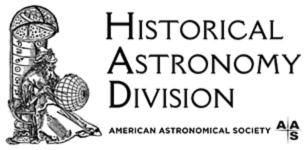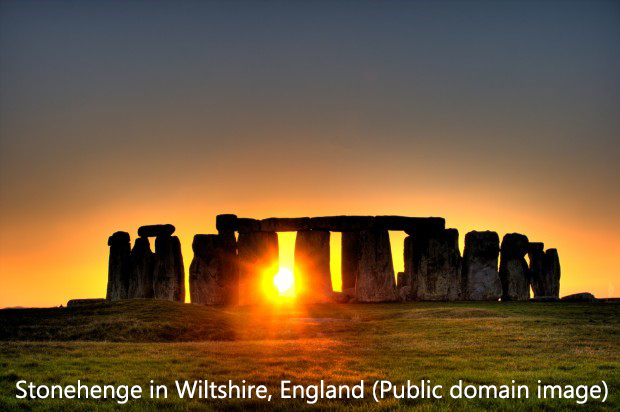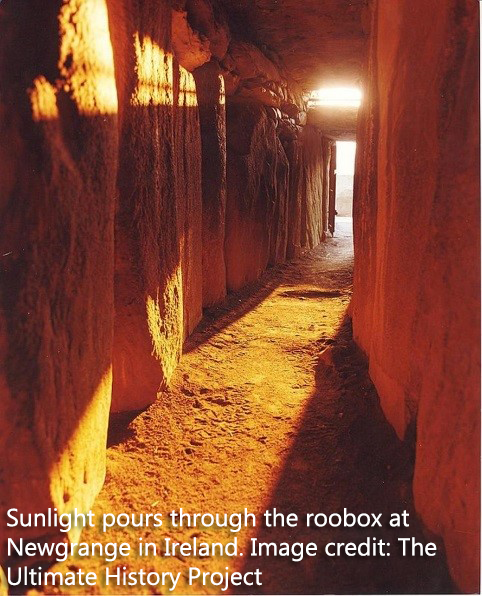This Month in Astronomical History: Winter Solstice & Archaeoastronomy
Teresa Wilson United States Naval Observatory
 Each month as part of this new series from the Historical Astronomy Division of the AAS, an important discovery or memorable event in the history of astronomy will be highlighted. This month, we look at the winter solstice and archaeoastronomy.
Each month as part of this new series from the Historical Astronomy Division of the AAS, an important discovery or memorable event in the history of astronomy will be highlighted. This month, we look at the winter solstice and archaeoastronomy.
 Between the days with the earliest sunset and the latest sunrise falls the day with the briefest daylight, commonly known as the winter solstice. This year, the winter solstice falls on 21 December in the northern hemisphere. The solstice, from the Latin "solstitium" (meaning "Sun standing still") happens when the Sun "stands still" over the Tropic of Capricorn, i.e., when the Sun reaches its most southerly declination of -23.5°. In other words, the North Pole is tilted furthest (23.5°) away from the Sun. For many today, the solstices hold no greater significance than the shortest and longest days of the year, but archaeology reveals that these days warranted considerable attention in many ancient cultures.
Between the days with the earliest sunset and the latest sunrise falls the day with the briefest daylight, commonly known as the winter solstice. This year, the winter solstice falls on 21 December in the northern hemisphere. The solstice, from the Latin "solstitium" (meaning "Sun standing still") happens when the Sun "stands still" over the Tropic of Capricorn, i.e., when the Sun reaches its most southerly declination of -23.5°. In other words, the North Pole is tilted furthest (23.5°) away from the Sun. For many today, the solstices hold no greater significance than the shortest and longest days of the year, but archaeology reveals that these days warranted considerable attention in many ancient cultures.
Stonehenge in Wiltshire, England, constructed between 3000 and 2000 BCE, is known for its strong archaeoastronomical associations and is aligned with the direction of sunrise on the summer solstice and sunset on the winter solstice. Each year, people from all over gather on these days. While the summer solstice draws a larger crowd, the winter solstice may have been more important to the ancient builders. At this time, cattle were slaughtered so the animals did not need to be fed through the winter, and wine and beer made previously had finally fermented. The other hint to the winter solstice's importance is the fact that the only other solstice-aligned monuments in the British Isles, Newgrange in Ireland and Maeshowe in Scotland, both face the winter solstice.
 Newgrange has been dated to around 3200 BCE, making it older than Stonehenge and even the Giza pyramids. Unlike Stonehenge’s large upright stones, Newgrange consists of a large circular mound with a stone passageway and interior chamber. While its exact purpose is unknown, there are clear ties to veneration of the dead as well as astronomy. At sunrise on the winter solstice, sunlight shines through a roofbox, a special opening above the doorway, directly along the passage, and into the inner chamber revealing the carvings inside for seventeen minutes. Today, the light enters the roofbox four minutes after sunrise, but calculations based on the precession of the Earth show that when the structure was being used, light would have entered right at sunrise. To experience the solstice from the inner chamber, one must enter a lottery from which 60 lucky winners are chosen.
Newgrange has been dated to around 3200 BCE, making it older than Stonehenge and even the Giza pyramids. Unlike Stonehenge’s large upright stones, Newgrange consists of a large circular mound with a stone passageway and interior chamber. While its exact purpose is unknown, there are clear ties to veneration of the dead as well as astronomy. At sunrise on the winter solstice, sunlight shines through a roofbox, a special opening above the doorway, directly along the passage, and into the inner chamber revealing the carvings inside for seventeen minutes. Today, the light enters the roofbox four minutes after sunrise, but calculations based on the precession of the Earth show that when the structure was being used, light would have entered right at sunrise. To experience the solstice from the inner chamber, one must enter a lottery from which 60 lucky winners are chosen.
Gaelic tribes from the British Isles were not the only peoples to have built structures that align with the winter solstice. At Chichen Itza in Mexico, the Sun appears to climb the terraces of a pyramid dedicated to the Mayan god Kukulcan on the winter solstice. In the Egyptian Temple of Karnak, the main axis, which bisects the complex, is aligned with the winter solstice sunrise. In the southern hemisphere, where the winter solstice falls in June, light from the rising sun on the solstice illuminates a special groove in the window of the Torreon tower at Machu Picchu in Peru.
The advent of the Christian era may have eclipsed the religious significance of the winter solstice that clearly existed in cultures across the world, but it still offers hope to those heading into months of snow and cold that the days are getting longer and warmer days are ahead.
Each month is an exciting new adventure into the archives of astronomical history, but before I continue any further, I would appreciate your feedback to ensure my writing is reaching the largest audience possible. Please participate in a brief questionnaire (approximately 10 minutes) about the style and content. You may also submit any suggestions for future topics. Thank you!

